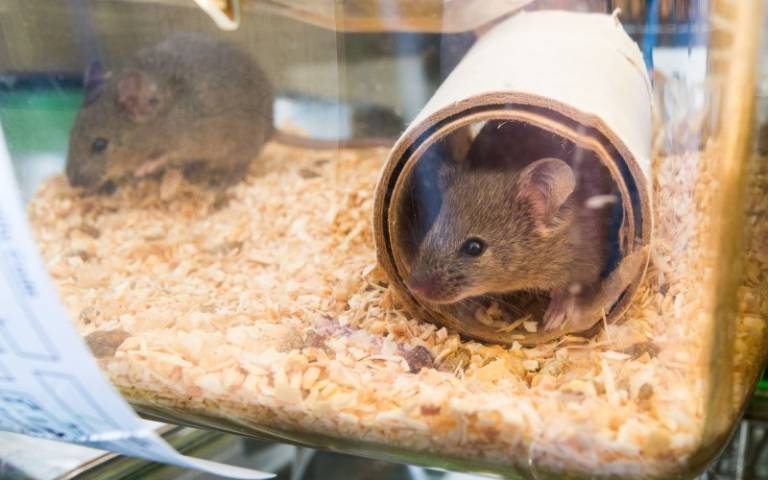Mice choose best escape route without ever experiencing threat
31 May 2022
Mice do not need previous experience of threat in order to respond to danger by choosing the shortest possible escape route, finds a new study led by UCL researchers.

In the new Current Biology study, the researchers show that mice can learn the shortest route to escape after only 10 minutes of exploring a new environment.
Lead author Professor Tiago Branco (Sainsbury Wellcome Centre at UCL) said: “In many neuroscience studies, mice are trained to solve complex mazes and are given lots of time to learn how to do so. But in nature, mice do not have that luxury – when faced with threat, they must escape to shelter as quickly as possible. The question is how do mice learn this very quickly, without the opportunity of trial and error.”
To explore this question, the researchers carried out a series of behavioural experiments where they gave mice a choice of two or three routes back to a shelter. The scientists used a loud sound or looming stimulus, simulating a predator, to scare the mice and then observed their route back to shelter.
Firstly, the neuroscientists blocked the direct path to shelter and found that the mice learned to use one of the other routes. Next, the researchers explored whether the mice could choose correctly between two paths of different lengths. The experiments took place in the dark, meaning that the mice could not see the shortest route. However, the researchers observed that mice indeed prefer the shorter path, particularly when there is a larger difference between the lengths of the two paths.
To understand how the mice learn this, the researchers studied those that were experiencing threat for the first time and observed that the inexperienced mice already had a preference for the shorter route. Thus, the mice must acquire this information through natural exploration and do not have to first experience threat to learn how to choose the best escape route. Furthermore, the mice learned this after only 10 minutes of exploring the environment.
Professor Branco said: “Mice are predated on by many species and so for a mouse it’s very important to know how to escape to safety. If you put a mouse in a new environment, its priority is to map out space and figure out how to get to a safe place. This is in the natural repertoire of the mouse’s behaviour and does not have to be explicitly instructed.”
Traditionally, the way that animals are thought to learn is to experience the value of something and map that onto the spatial geometry. For example, if mice were repeatedly exposed to threat many times and felt stressed by taking the long path back to safety, they would assign the longer path a lower value and learn to take the shorter path instead.
However, in this experiment, the animals were not doing that. Instead, the mice assumed that the short route was best for escape. The researchers refer to this assumption as an innate heuristic. Through evolution, mice have acquired a set of neural circuits that give them the ability to make these innate choices after natural exploration.
“Animals are very good at learning about the things that matter to them. To understand the mouse brain and the algorithms and neural circuits that support learning, it is important to look at the behaviours that the mouse has evolved to do and the constraints that they are under to learn fast and efficiently,” Professor Branco added.
To explore the algorithms the brain might be using to enable the mice to choose the best escape route, the researchers looked at three different computational models and asked whether the artificial algorithms could perform as well as the mice in the task. They found that the three algorithms all worked very well if the artificial mouse was allowed to explore for a long time. However, the real mouse only had 10 minutes to explore.
And so the researchers fed the artificial mouse with the trajectories that the real mouse took and they found that the simplest possible algorithm, called model-free, could not learn to choose the shortest path. The two more complex models, called model-based, could learn the best escape route but they were only correct around half of the time. This gives the researchers some insights into what the brain needs for the mice to be able to select the optimal escape route.
The next steps for the researchers are to delve deeper into how this works in the brain and how mice map value onto actions in this natural paradigm. This question is one small piece of the larger puzzle of how animals choose what actions they are going to do based on their expectation of what is going to be best in the short-term or long-term. The neuroscientists hope to understand this form of value mapping in an action behaviour to gain a glimpse into the kinds of algorithms the brain may be using to implement rapid learning.
This research was funded by Wellcome with support from the Gatsby Charity Foundation.
Links
- Research paper in Current Biology
- Professor Tiago Branco’s academic profile
- Sainsbury Wellcome Centre at UCL
Image
- Research mice at UCL (Credit: David Bishop, UCL)
Media contact
Chris Lane
Tel: +44 (0)20 7679 9222
Email: chris.lane [at] ucl.ac.uk
 Close
Close

